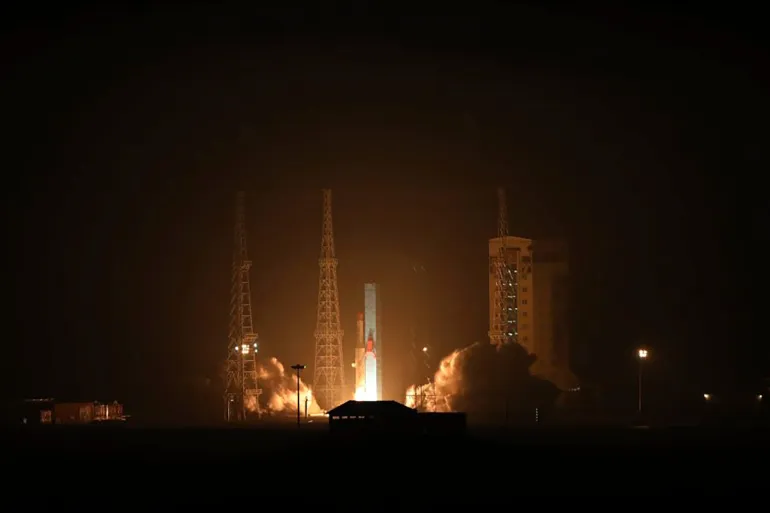Iran Launch 3 Satellites After UK, France, & Germany Statement
30th Jan 2024
Iran’s Ministry of Defence (MoD) has launched three satellites concurrently into Earth’s elliptical orbit. As this was the first time that the country had launched multiple satellites from one rocket, it would normally be heralded as a technological milestone. However, the feat is lost behind concerns about Iran’s intentions. The move followed a previous launch on 20th January, which saw the UK, Germany and France (E3) publish a joint statement in unified condemnation. The E3 claimed that the technology used to develop the launch vehicle that delivered Iran’s previous satellite is interchangeable with ballistic missile technology.
The E3’s 26th January statement read: “On 20 January Iran announced the launch of the Soraya satellite using the Ghaem-100 Space Launch Vehicle (SLV). We condemn this launch, as this SLV uses technology essential for the development of a long-range ballistic missile system. Iran continues to develop its missile programme despite repeated international calls to halt it, and after years of disregarding UN restrictions.”
Iran’s 29th January Satellite Launch
On 29th January, Iran’s MoD announced the successful simultaneous launch of three satellites onboard their Simorgh rocket from the Imam base. After the rocket took off, all three satellites were placed in elliptical orbit. The satellites in question were two nanosatellites, labelled Keihan 2 and Hatef 1, and the larger Mehda satellite.
Whilst in operation, the satellites will sit at a minimum 450 km altitude, whereas the maximum altitude will hit 1,110 km. Iran has been active in space odysseys recently, after they launched a capsule containing animals in December last year. This is in addition to purportedly supplying Yemen militants with missiles to target Israeli assets. Significantly, one of these missiles reportedly flew out of the atmosphere before being shot down above the generally recognized demarcation line for space.
More recently, however, Iran launched another satellite into orbit which engendered E3’s response. Therefore, Iran is showing no signs that they are prepared to relinquish their space development plans – much to the West’s dismay.
The Mehda Satellite
Iran has been developing a range of lightweight satellites, with the recently launched Mehda satellite being one of them. Currently, little information regarding the Mehda satellite has been released, only that it’s a research satellite. What the satellite will be researching appears to be a closely guarded national secret.
However, the main aim of the launch was to test the “accuracy of the Simorgh [rockets] performance”, when inserting numerous spacecraft into orbit. Additionally, Iran persevered with the launch to identify and validate the “performance of some new designs”, namely, Iranian built technology and their reliability as in-space assets.
The Two Nanosatellites: Keihan 2 and Hatef 1
The first of the two nanosatellites is the Kaihan 2 spacecraft. This is the introductory satellite for a range of upcoming “cubic satellites [designed by] Sairan Company”, Iran’s MoD said. In contrast to Mehda, more information on this satellite was released.
Its function will be to “prove [Iran’s] positioning technology”, Iran’s MoD said. In addition, Kaihan 2 will operate independently outside of global positioning systems, as well as ground receivers. Furthermore, Kihan 2 was also placed “stably and precisely towards Earth”. As such, Iran said this was in order to enhance the satellites “status determination and control subsystem”.
Secondly, Hatef 1 is also a nano cube satellite developed by the Ministry of Defence’s Electronic Industries Company. The purpose of this satellite is to validate Iran’s narrowband communications technology, via the use of satellite IoT. Iran explained: “this satellite has been launched into space as the first test version of the Shahid Soleimani satellite system.”
Comments From The West & Ballistic Missile Development
Prior to launching the three satellites, Iran sent their Soraya satellite into orbit on 20th January. Six days later, the UK, France, and Germany issued a condemnation statement. Generally, the E3’s concerns surrounded the satellite’s launch vehicle, Ghaem-100. E3 contended that the rocket yields similar technology that’s used to develop ballistic missiles.
E3 stated:
“launches such as these allow Iran to test technology that could be used to further develop its ballistic missile programme, which poses a significant threat to regional and international security. We have longstanding concerns over Iran’s activity related to ballistic missile technologies that are capable of delivering nuclear weapons. These concerns are reinforced by Iran’s continued nuclear escalation beyond all credible civilian justification.”
“The governments of France, Germany and the United Kingdom remain committed to taking every diplomatic step to prevent Iran from developing nuclear weapons and to hold Iran to account for its destabilising activity in the region and internationally.”
This time round, the three satellites were launched on a different rocket: the two-stage liquid fuelled Simorgh-1. After marking its seventh research launch, Iran’s MoD remarked: “[Simorgh-1] was able to open a new door to the country’s space launches by injecting multiple satellites.” Further statements from E3 regarding the simultaneous launch have not been released.







Thank you for your comment! It will be visible on the site after moderation.